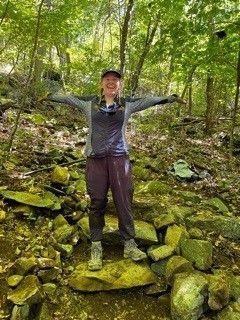
Photo of Jennifer Schmid
March is Women’s History Month. Women are often under and misrepresented in outdoor spaces. When I completed a section hike of the AT with my sister, I commemorated the trip by buying a poster from Shenandoah National Park. I loved this poster. It had all the hikes we did together as little girls. We intentionally completed our section hike to connect all these sites. However, I could not find the same poster with a woman on it.
I bought it anyways, took it home, and drew a ponytail on it.
In recognition of Women’s History Month, today’s blog post highlights women leaders who helped shape the Appalachian Trail and PATC into what they are today. Additionally, it serves to illuminate the work we have left to do to create a welcoming space for women.
Though the PATC was originally founded as a trail club open exclusively to men, there were many influential women along the way that helped mold the club into what it is today.
Although Myron Avery is often touted as the founder of the Potomac Appalachian Trail Club, he also had the support of Dr. Jean Stephenson. Dr. Stephenson was an active member in the Potomac Appalachian Trail Club. She served on the executive committee of the Appalachian Trail Conference and edited the club's Trailways News for 30 years. Stephenson edited the first two generations of AT guidebooks.
Her skills went beyond writing and editing. She received a doctorate in law from National University and was Cornell University educated. I suspect her role in PATC was far greater than serving as Myron Avery’s secretary. In 2012, she was inducted into the Appalachian Trail Hall of Fame.
Ruth Blackburn was the first female president of PATC. Blackburn is known for her work to secure a protected trail corridor, and she devoted years to researching private land ownership along the A.T. She was recognized as an expert in land ownership from Virginia to Pennsylvania. Blackburn went on to become chair of the Appalachian Trail Conservancy from 1980 to 1983, which was a crucial time for land acquisition because of federal mandates to complete a continuous trail.
The PATC Blackburn Trail Center is named after Ruth. In 1983, the first annual Pig Roast was held at the Blackburn Trail Center. A couple of years later, the summer B-B-Q was instituted. The annual Pig Roast and Summer B-B-Q events each attract 60 to 80 attendees annually and are important fundraisers for PATC. Ruth Blackburn died at the age of 96 in 2004.
Dr. Anna Michener was an early and influential leader in PATC. I found her name in the early 1936 and 1937 newsletters. In the 1936 newsletter, she notably maintained Pine Grove Furnace to Tumbling Run Road. Anna Michener received her Ph.D. in political science from Columbia University. A PATC cabin named after Anna Michener received a new roof in 2020. Members of the PATC can book the Michener cabin here.
Katheryn Fulkunson’s name also appeared in the early newsletters. She donated the Highacre cabin in 1962. She and her friend Marian Lapp purchased the house in 1939. They used the Victorian-style house as their summer home and for PATC gatherings. I can only imagine the hurdles two women faced purchasing a home together in the 1930s. Fulkunson’s diaries and logbooks are kept at the Special Collections Research Center at William and Mary. Some of her logbooks include information related to automobile travel associated with the Potomac Appalachian Trail Club. Members of PATC can book the Highacre Cabin here.
I had fun learning about these women’s lives and understanding the importance of their contributions to PATC. It has also made me think about how women are treated and viewed in outdoor spaces today.
Though we have come a long way as a society and in the outdoor community, there is still much work to be done. I was struck by my experience at a workshop with PATC in the Fall. We went around in a circle introducing ourselves. One man introduced himself and his wife. The woman never spoke. This happened twice.
Later, during a seminar on invasive plant species, a woman raised her hand to ask the first question. A man in the group interrupted her, instructed her to wait until the end for questions, and then proceeded to ask his own question halfway through…to which, the presenter replied, “I was going to get to that.”
In yet another instance, during a workshop about saws, gendered comments were made about the way in which a man vs. a woman might handle a saw. “Did you know women are better at handling saws because they offer more finesse?” I can tell you in that moment, if given a saw, I would not have used it with such finesse.
There is a difference between being included in spaces and being welcomed in spaces. Thank you to those men who welcomed me to my first PATC workshop. Thank you for having open conversations about the gendered experience. Your curiosity and inquiry move PATC forward. Many of you contributed to a fantastic weekend. Thank you also to the women I found shared comradery with. I look forward to more opportunities to learn about trail maintenance.
We have come a long way in including women in outdoor spaces. Will you welcome us too?
Learn more about the history of women and the AT in Gwenyth Loose’s book “We Were There Too: Pioneering Appalachian Trail Women,” published in November 2020 by the Appalachian Trail Conservancy (ATC). Support the Appalachian Trail Museum by purchasing directly through their website here instead of buying the book on Amazon.
